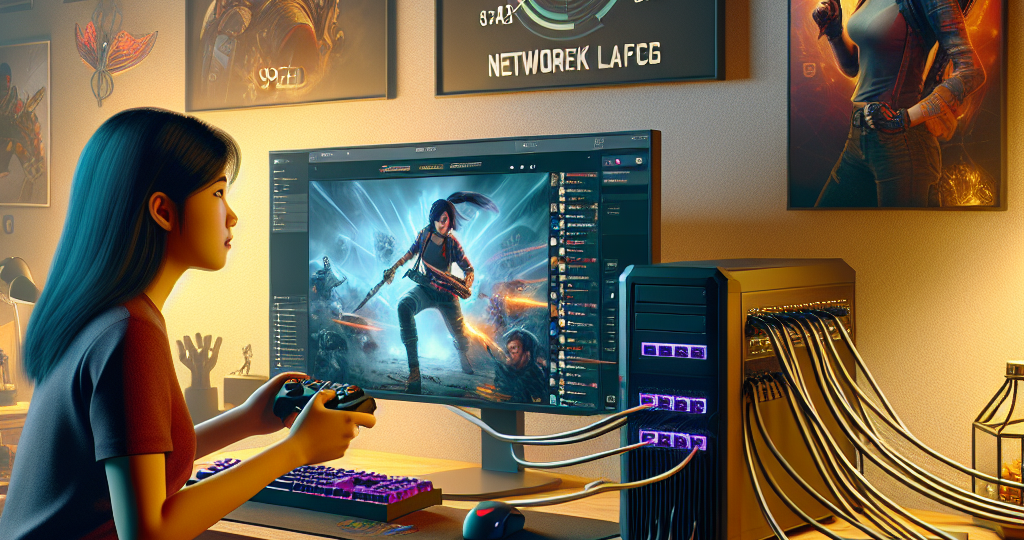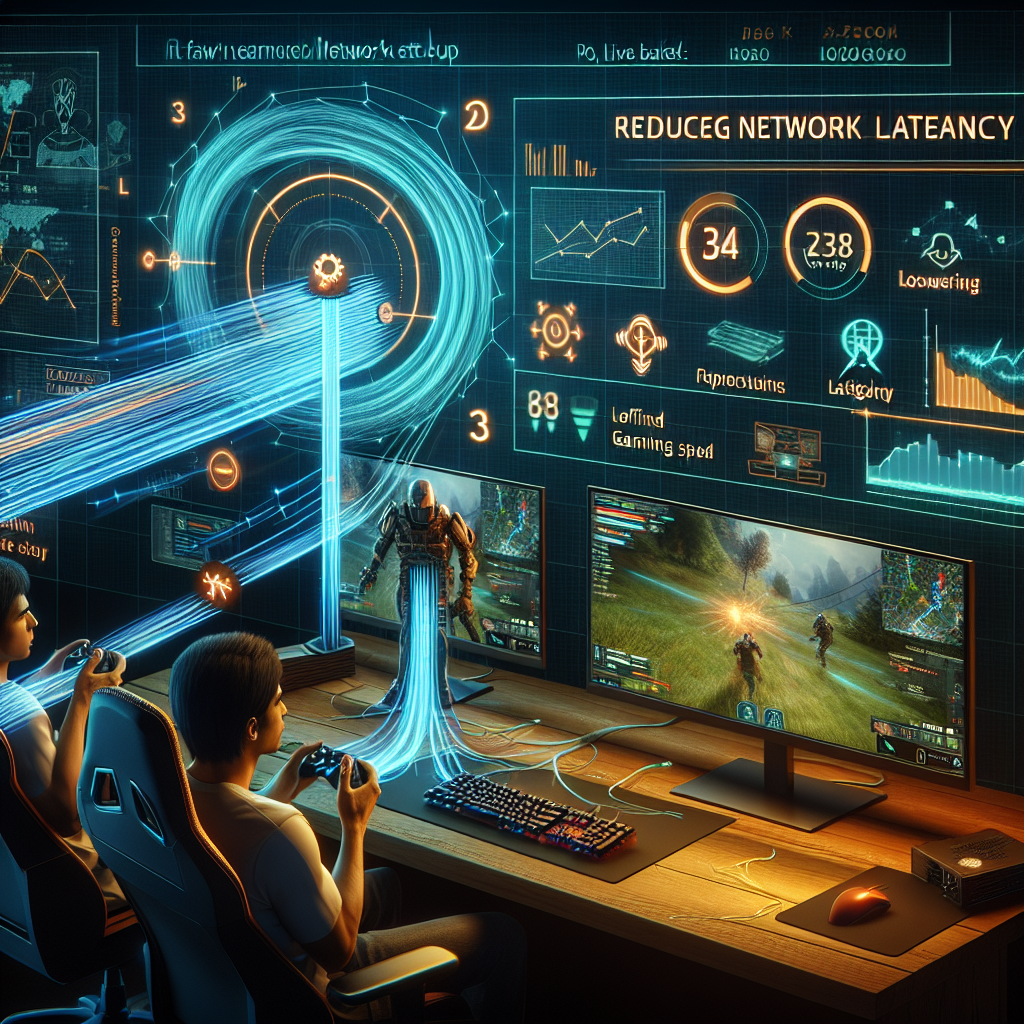Best Practices for Reducing Network Latency in Online Gaming
September 12, 2024 | by Willie Brockington

In the fast-paced world of online gaming, reducing network latency is essential for a smooth and enjoyable gaming experience. Network latency refers to the delay in data transmission between a player’s device and the game server, causing lag and affecting gameplay. To optimize performance and minimize latency issues, it is crucial to implement best practices such as utilizing a wired internet connection, upgrading hardware and software, configuring network settings, and selecting the right gaming server. By following these proactive measures, gamers can ensure a responsive and seamless gaming environment, enhancing their overall gameplay experience.
Understanding Network Latency in Online Gaming

– Definition of network latency in the context of online gaming
Network latency in online gaming refers to the delay between when a player initiates an action in the game and when the server processes and responds to that action. It is the time it takes for data to travel from the player’s device to the game server and back. Latency is measured in milliseconds (ms) and can significantly impact the responsiveness and smoothness of gameplay.
- Impact of network latency on gaming experience
High network latency can result in various detrimental effects on the gaming experience, including:
-
Lag: Players may experience delays between their actions and the game’s response, leading to a jerky or stuttering gameplay experience.
-
Disconnections: Unstable network connections with high latency can cause players to be disconnected from game servers, resulting in interruptions and frustration.
-
Inaccurate gameplay: Latency can cause discrepancies between what players see on their screens and what is actually happening in the game world, leading to inaccuracies in aiming, movement, and overall gameplay performance.
In online gaming, minimizing network latency is crucial to ensure a smooth and enjoyable gaming experience for players.
Factors Contributing to Network Latency
Hardware Related Factors
When it comes to reducing network latency in online gaming, the hardware components play a crucial role in determining the overall performance. The following are some key factors related to hardware that can impact network latency:
- Quality of Hardware Components:
- Using high-quality routers and network adapters can significantly reduce latency by ensuring faster data transmission and reception.
-
Low-quality hardware may introduce delays in processing data packets, leading to increased latency during online gaming sessions.
-
Network Interface Cards (NICs):
- Upgrading to NICs with higher data transfer rates can help in reducing latency by enabling faster communication between the gaming device and the network.
-
NICs with advanced features such as offloading capabilities can offload tasks from the CPU, further optimizing network performance and reducing latency.
-
Router Configuration:
- Configuring routers for optimized performance, such as enabling Quality of Service (QoS) settings for gaming traffic, can help prioritize gaming data packets and reduce latency.
- Ensuring that routers are placed in optimal locations to minimize signal interference and maximize network coverage can also contribute to lower latency in online gaming.
In conclusion, investing in high-quality hardware components, including routers, network adapters, and NICs, and optimizing their configurations can greatly improve network latency in online gaming and enhance the overall gaming experience for players.
Software Related Factors
In the realm of online gaming, network latency can often be attributed to various software-related factors that are crucial in determining the overall gaming experience. These factors play a significant role in either exacerbating or mitigating latency issues, thereby directly impacting the fluidity and responsiveness of gameplay.
- Role of software optimization in reducing network latency
Software optimization stands as a cornerstone in the quest to minimize network latency in online gaming. This process involves fine-tuning and streamlining the code and algorithms within the game software to ensure efficient data transmission and processing. By eliminating redundant processes, reducing the workload on the network, and enhancing the overall performance of the software, optimization can significantly alleviate latency issues. Moreover, optimizing the software can lead to faster response times, smoother gameplay, and ultimately enhance the overall gaming experience for players.
- Importance of keeping gaming software updated
One critical aspect that is often overlooked but holds immense significance in reducing network latency is the regular updating of gaming software. Developers frequently release updates and patches not only to introduce new features but also to address bugs, security vulnerabilities, and performance issues that could contribute to latency. By staying up to date with the latest versions of gaming software, players can benefit from optimized code, improved network protocols, and enhanced server connectivity, all of which contribute to a reduction in latency. Failure to update gaming software can result in compatibility issues, inefficiencies in data transmission, and ultimately lead to heightened latency issues during gameplay.
Network Related Factors
- Impact of network congestion on latency
Network congestion refers to the situation where the network experiences a high volume of data traffic, leading to delays in data transmission. In online gaming, network congestion directly impacts latency, causing delays in the communication between the player’s device and the game server. This delay can result in lag, affecting the player’s ability to react quickly in the game environment. To reduce the impact of network congestion on latency, game developers can implement strategies such as data compression, traffic prioritization, and load balancing to ensure a smoother gaming experience for players.
- Significance of choosing the right internet service provider
The choice of internet service provider (ISP) plays a crucial role in determining network latency in online gaming. Different ISPs offer varying levels of network stability, speed, and reliability, which directly impact latency during gameplay. When selecting an ISP for online gaming, players should consider factors such as bandwidth capacity, latency rates, and network infrastructure. Opting for a high-quality ISP with a robust network infrastructure can help reduce latency issues and provide a more seamless gaming experience. Additionally, choosing an ISP with dedicated gaming servers and low contention ratios can further minimize latency and enhance overall gameplay performance.
Strategies for Minimizing Network Latency
Optimal Network Configuration
In online gaming, achieving optimal network configuration is paramount to reducing latency and ensuring a seamless gaming experience. The following strategies can significantly enhance network performance:
-
Setting up a wired connection for stable latency: Utilizing a wired Ethernet connection instead of relying on Wi-Fi can notably reduce latency in online gaming. Wired connections offer more stability and consistency in data transmission, minimizing the risk of interference or signal loss that can occur with wireless connections. By directly connecting the gaming device to the router via Ethernet cable, players can experience lower latency and a more reliable connection during gameplay.
-
Configuring Quality of Service (QoS) settings on routers: Quality of Service (QoS) settings on routers allow users to prioritize gaming traffic over other internet activities, effectively reducing latency during online gameplay. By allocating more bandwidth to gaming applications and limiting bandwidth usage for non-essential tasks, such as downloads or streaming, QoS ensures that gaming data packets are transmitted without delays or interruptions. Customizing QoS settings to prioritize latency-sensitive gaming traffic can significantly enhance the overall gaming experience and optimize network performance for online gaming sessions.
Choosing the Right Internet Service Provider
When it comes to minimizing network latency in online gaming, selecting the appropriate Internet Service Provider (ISP) can make a significant difference in the overall gaming experience. Below are key considerations to keep in mind when choosing an ISP:
-
Researching ISPs with low latency and high reliability: Conduct thorough research on ISPs in your area to identify those known for providing low latency connections. Look for ISPs that have a reputation for offering stable and reliable services, as network interruptions can lead to increased latency during gaming sessions.
-
Considering fiber-optic connections for reduced latency: Fiber-optic connections are known for their high speeds and lower latency compared to traditional cable or DSL connections. When possible, opt for an ISP that offers fiber-optic internet service to minimize latency issues during online gaming. The enhanced speed and stability of fiber-optic connections can help reduce lag and ensure a smoother gaming experience.
Utilizing Gaming VPNs
-
Understanding how VPNs can improve latency in online gaming: VPNs can help reduce network latency in online gaming by providing a more direct and efficient route for data packets to travel between the player’s device and the game server. By encrypting and rerouting the internet connection through VPN servers located closer to the game server, VPNs can bypass congested or inefficient network pathways, resulting in lower latency and smoother gameplay experience for the player.
-
Selecting VPNs optimized for gaming performance: When choosing a VPN for online gaming, it is essential to select one that is specifically optimized for gaming performance. Look for VPN providers that offer low-latency servers strategically located near popular game servers. Additionally, consider VPNs that offer features such as dedicated gaming servers, high-speed connections, and advanced routing algorithms designed to prioritize gaming traffic for minimal latency. By selecting a gaming-focused VPN service, players can effectively reduce network latency and improve their overall gaming experience.
Location and Server Selection
- Importance of choosing servers closer to your geographical location
In online gaming, the physical distance between a player and the game server plays a crucial role in determining network latency. When selecting a server, opting for one that is geographically closer to your location can significantly reduce latency. This is due to the shorter distance data packets have to travel, resulting in quicker response times between the player’s actions and the game server’s feedback. By minimizing the geographical distance, players can experience smoother gameplay with reduced delays and lag spikes.
- Impact of server load on latency during peak gaming hours
Another factor to consider when selecting a game server is the server load, especially during peak gaming hours. Game servers can experience increased traffic and activity during specific times of the day when more players are online simultaneously. This heightened server load can lead to latency issues, affecting the responsiveness of the game and causing delays in player actions. By choosing servers with lower loads or less congestion, players can mitigate the impact of peak gaming hours on network latency. Additionally, monitoring server load and choosing servers with scalable infrastructure can help maintain optimal latency levels even during busy periods.

Best Practices for Network Monitoring and Optimization
Use of Network Monitoring Tools
Network monitoring tools play a crucial role in identifying and addressing latency issues in online gaming environments. These tools provide real-time insights into network performance metrics, allowing gamers to pinpoint bottlenecks and optimize their connections for a smoother gaming experience.
Benefits of monitoring network performance for latency issues:
- Real-time Visibility: Network monitoring tools offer real-time visibility into network traffic, latency levels, and packet loss, enabling gamers to identify issues as they occur.
- Troubleshooting: By monitoring network performance, gamers can quickly troubleshoot and resolve latency issues, minimizing disruptions during gameplay.
- Performance Optimization: Monitoring tools help users optimize their network settings, such as adjusting Quality of Service (QoS) parameters or prioritizing gaming traffic, to reduce latency and improve overall gaming performance.
- Proactive Maintenance: Regular monitoring allows gamers to proactively address potential latency issues before they impact gameplay, ensuring a seamless gaming experience.
Recommended network monitoring tools for gamers:
- PingPlotter: PingPlotter is a popular network monitoring tool that provides visualizations of network performance metrics, including latency, packet loss, and jitter. Gamers can use PingPlotter to identify network issues and troubleshoot connectivity problems in real-time.
- Wireshark: Wireshark is a powerful network protocol analyzer that allows gamers to capture and analyze network traffic, helping them diagnose latency issues and optimize network configurations for gaming.
- Speedtest by Ookla: Speedtest by Ookla is a simple yet effective tool for testing internet speed and latency. Gamers can use Speedtest to measure their connection quality, identify potential latency issues, and make informed decisions to improve network performance.
- Net Uptime Monitor: Net Uptime Monitor is a lightweight monitoring tool that tracks network uptime and performance metrics. Gamers can use this tool to monitor latency levels over time, detect patterns of network congestion, and take proactive measures to minimize latency during online gaming sessions.
Regular Maintenance and Updates
Best Practices for Network Monitoring and Optimization
In the realm of online gaming, the significance of conducting regular maintenance and updates cannot be overstated. By adhering to this best practice, online gamers can effectively reduce network latency and ensure a smoother gaming experience.
- Importance of keeping hardware and software up to date: One of the primary factors contributing to network latency in online gaming is outdated hardware and software. Ensuring that both the hardware components, such as routers, switches, and modems, as well as the software applications and drivers, are up to date is crucial in minimizing latency issues. Updated hardware and software are better equipped to handle the demands of online gaming, resulting in reduced latency and improved performance.

– Performing regular maintenance to prevent latency issues: Regular maintenance tasks, such as cleaning up temporary files, optimizing system settings, and monitoring network traffic, play a pivotal role in preventing latency issues in online gaming. By routinely maintaining and optimizing both the hardware and software components of the network, gamers can proactively identify and address potential latency triggers before they escalate into significant performance issues. Regular maintenance not only enhances the overall efficiency of the network but also contributes to a seamless gaming experience with minimal latency disruptions.
Collaborative Efforts and Community Feedback
Engaging with Online Gaming Communities
Engaging with online gaming communities is a valuable strategy for reducing network latency in online gaming. By actively participating in these communities, players can gain insights, tips, and recommendations from experienced gamers who have likely encountered and resolved similar latency issues. This collaborative approach can offer a wealth of knowledge and practical solutions to improve gameplay performance. Here are some ways to effectively engage with online gaming communities:
-
Seeking advice and tips from experienced gamers: Experienced gamers within online communities often have a wealth of knowledge on optimizing network settings, selecting the best servers, and utilizing software tools to minimize latency. By reaching out to these individuals for advice and tips, players can benefit from their expertise and potentially uncover new strategies to reduce network latency.
-
Participating in forums to troubleshoot latency issues: Online forums dedicated to specific games or gaming platforms are excellent resources for troubleshooting latency issues. By actively participating in these forums, players can seek assistance from community members, share their experiences with latency problems, and collaborate on finding effective solutions. Engaging in discussions, asking questions, and providing feedback can lead to valuable insights and recommendations for addressing network latency issues in online gaming.
Feedback and Communication with ISPs
- Importance of Providing Feedback:
-
Online gaming companies play a crucial role in reducing network latency by providing detailed feedback to Internet Service Providers (ISPs). This feedback is essential for ISPs to understand the specific needs and challenges faced by gamers.
-
Specificity in Feedback:
-
When communicating with ISPs, online gaming companies should be specific about the latency issues experienced by players. Detailed reports on when and where latency spikes occur can help ISPs pinpoint the root causes and implement targeted solutions.
-
Collaborative Problem-Solving:
-
By fostering open communication channels with ISPs, gaming companies can collaborate on identifying and resolving latency issues. This partnership approach allows for tailored solutions that address the unique requirements of online gaming networks.
-
Regular Monitoring and Reporting:
- Establishing a system for regular monitoring and reporting of network latency metrics is essential for maintaining effective communication with ISPs. By sharing real-time data on latency performance, gaming companies can proactively address issues and work towards continuous improvement.
FAQs: Best Practices for Reducing Network Latency in Online Gaming
What is network latency and how does it affect online gaming?
Network latency refers to the delay that occurs when data is sent between two devices over a network. In online gaming, latency can result in delays between actions taken by players and their effects in the game world. This can lead to lag, which can be frustrating for players as it impacts their ability to react in real-time.
How can I reduce network latency in online gaming?
There are several best practices you can follow to reduce network latency in online gaming. One strategy is to connect to a wired network instead of using Wi-Fi, as wired connections typically have lower latency. Additionally, minimizing the number of devices connected to your network and ensuring that your router is up to date can help improve latency. Using Quality of Service (QoS) settings on your router to prioritize gaming traffic can also reduce latency.
Is there anything I can do on my end to optimize my gaming experience?
Yes, there are a few things you can do on your end to optimize your gaming experience and reduce latency. Closing any unnecessary background applications on your device can free up resources and improve network performance. Additionally, selecting gaming servers that are closer to your physical location can help reduce latency. Finally, regularly updating your network and gaming hardware, such as your router and graphics card, can also improve latency.
Are there any specific in-game settings I should adjust to reduce network latency?
Adjusting certain in-game settings can also help reduce network latency in online gaming. Lowering graphics settings can reduce the amount of data that needs to be transferred between your device and the game server, which can improve latency. Disabling features such as motion blur and shadows can also help optimize performance and reduce latency. Furthermore, turning off any unnecessary background processes within the game itself can improve network performance.
The Ultimate Guide to Reducing Latency on Your Internet Connection
RELATED POSTS
View all


